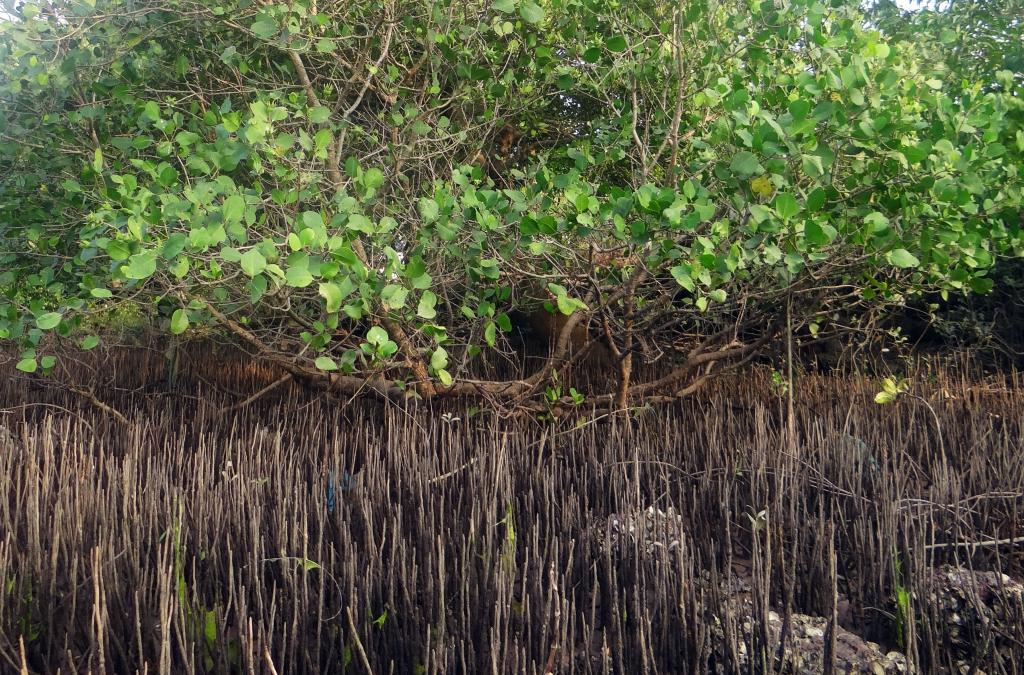
The following article is a winning entry for the month of August 2023 for the competition ‘Youth Climate Journalist Support Programme on Commons,’ organized by the Youth4Water, Bhubaneshwar and sponsored by the Foundation for Ecological Security, Gujarat. The competition is promoted on the Twitter handle: @Youth4WaterIn via #Youth4WaterIndia and #PromiseOfCommons.
The triple planetary crisis refers to three interconnected environmental crises that pose a threat to humanity—climate change, pollution, and biodiversity loss. We need to address this crisis by adapting to nature-based solutions that can leverage the inherent resilience of our ecosystem. One such solution is the conservation of mangroves.
Mangroves are the kind of trees that are found in intertidal zones, between high tide and low tide, in tropical and subtropical regions. They are halophytic i.e., salt tolerant in nature and grow under anaerobic conditions in muddy soils where freshwater and seawater is available. In these stringent conditions, they thrive by various adaptations, like aerial roots, and techniques, like salt excretion.

Mangroves with their aerial roots (Photo credits: Bishnu Sarangi from Pixabay)
Mangroves are integral to the blue carbon ecosystem. Blue carbon is simply the term for carbon captured by our oceans and coastal ecosystems. Mangroves store carbon in their in roots and fix it in the soil; this carbon is four times more compared to the one fixed by other tropical forests. Since mangroves grow in waterlogged conditions, this sequestered carbon is not oxidised to carbon dioxide and, therefore, forms a carbon sink in the region.
Apart from helping with carbon sequestration, mangroves also protect us from calamities and natural hazards, and save the money we would otherwise spend on protective and precautionary infrastructure. They reduce coastal erosion by binding the soil with their roots. They act as wetlands which absorb water and hence mitigate urban flooding. They also filter excess nutrients and industrial waste from water, thereby cleaning it and reducing the occurrence of harmful algal blooms. Most importantly, mangroves cushion the coasts from storms and tsunamis by dissipating wave energy.
 During the tsunami in the Indian Ocean in 2004, mangroves proved to be an effective nature-based solution as they buffered the coasts and reduced the deaths caused. Thus, mangroves which had been neglected for decades eventually proved to be a boon in disguise and people gradually became aware of their ecological and economic importance.
During the tsunami in the Indian Ocean in 2004, mangroves proved to be an effective nature-based solution as they buffered the coasts and reduced the deaths caused. Thus, mangroves which had been neglected for decades eventually proved to be a boon in disguise and people gradually became aware of their ecological and economic importance.
Many mangrove forests were cleared to make way for various anthropogenic activities, like agriculture, aquaculture, urbanization, tourism, and industrialization. They were also degraded whenever there was an imbalance in the fresh and saltwater content in their habitat caused due to rampant construction of river dams.
Mangroves are vital breeding grounds for fishes and crustaceans, and home to diverse migratory birds, animals, and bacteria. They support sea grasses and coral reefs. Several local communities depend on them for fruits, herbs, timber, and a good fish catch.
 That is why it is necessary to protect them and the local population has a significant role to play in it. Mikoko Pamoja, the world's first community-based mangrove conservation project located in Gazi Bay village in Kenya, has become a reality only due to the participation of the local community. The villagers conserved the mangroves for years instead of cutting them down and are now rightfully gaining from it. They have abundant water supply and a good source of livelihood owing to the mangroves. Their earning from the forest is supporting their children’s education and the country is also benefitting through the voluntary carbon credit market.
That is why it is necessary to protect them and the local population has a significant role to play in it. Mikoko Pamoja, the world's first community-based mangrove conservation project located in Gazi Bay village in Kenya, has become a reality only due to the participation of the local community. The villagers conserved the mangroves for years instead of cutting them down and are now rightfully gaining from it. They have abundant water supply and a good source of livelihood owing to the mangroves. Their earning from the forest is supporting their children’s education and the country is also benefitting through the voluntary carbon credit market.
Thus, community-based projects help in protecting the mangroves and ensure the livelihood of indigenous peoples. Mangrove conservation is, therefore, a sustainable way to combat the triple planetary crisis to secure a more resilient and prosperous future for generations.
Some unique fish and plant species found in mangrove forests (Photo credits: Mangrove Action Project and Pixabay)